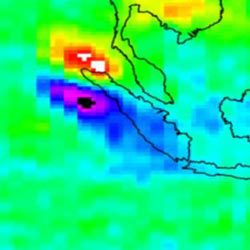How much is the Earth’s melting land ice contributing to global sea-level rise? A team of scientists based at the University of Colorado, in Boulder, has plugged in to NASA data to try to answer this question as accurately as possible, in an attempt to gauge the future threat from rising sea levels, as well as the impact of climate change on cold-climate parts of the globe.
In what the US space agency has described as the first comprehensive satellite study of its kind, the research team has used data from the NASA/German Aerospace Center Gravity Recovery and Climate Experiment (GRACE), to measure ice loss in all of Earth’s land ice between 2003 and 2010, with a particular focus on glaciers and ice caps outside of Greenland and Antarctica.
According to the NASA website, “the twin GRACE satellites track changes in Earth’s gravity field by noting minute changes in gravitational pull caused by regional variations in Earth’s mass, which for periods of months to years is typically because of movements of water on Earth’s surface. It does this by measuring changes in the distance between its two identical spacecraft to one-hundredth the width of a human hair.”
So what did the researchers find? They found that the total global ice mass lost from Greenland, Antarctica and the Earth’s glaciers and ice caps during the study period was about 4.3 trillion tonnes (1,000 cubic miles – apparently that’s enough ice to cover the US with a 1.5 feet deep layer), which has added about 0.5 inches (12 millimeters) to global sea level.
“Earth is losing a huge amount of ice to the ocean annually, and these new results will help us answer important questions in terms of both sea rise and how the planet’s cold regions are responding to global change,” said University of Colorado Boulder physics professor John Wahr, who helped lead the study. “The strength of GRACE is it sees all the mass in the system, even though its resolution is not high enough to allow us to determine separate contributions from each individual glacier.”
The study – the full results of which were published in the journal Nature early this month (subscription) – found that about a quarter of the average annual ice loss came from glaciers and ice caps outside of Greenland and Antarctica (roughly 148 billion tonnes, or 39 cubic miles); while ice loss from Greenland and Antarctica and their peripheral ice caps and glaciers averaged 385 billion tonnes (100 cubic miles) a year.
One unexpected result from the GRACE study was that the estimated ice loss from high altitude Asian mountain ranges like the Himalaya, the Pamir and the Tien Shan, was about 4 billion tonnes annually – a relatively small amount compared to previous ground-based estimates that have ranged up to 50 billion tonnes annually.
“This study finds that the world’s small glaciers and ice caps in places like Alaska, South America and the Himalayas contribute about 0.02 inches per year to sea level rise,” said Tom Wagner, cryosphere program scientist at NASA Headquarters in Washington. “While this is lower than previous estimates, it confirms that ice is being lost from around the globe, with just a few areas in precarious balance. The results sharpen our view of land-ice melting, which poses the biggest, most threatening factor in future sea level rise.”










